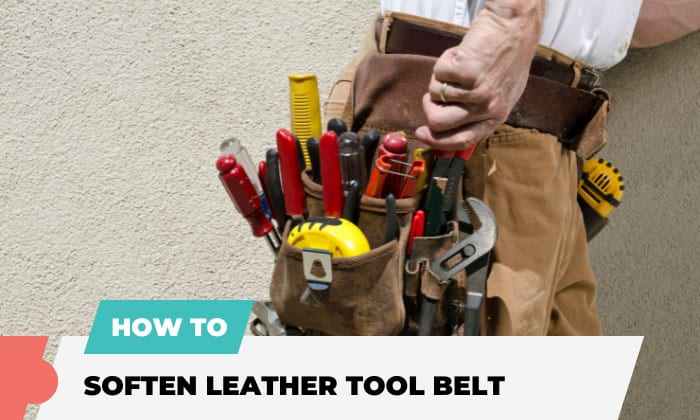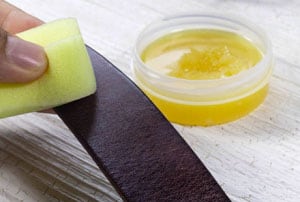Leather stands out as being the most common material to produce mechanic tool belt and belts for various jobs. Regarding durability, leather can beat other fabrics such as nylon, polyester, and more. This sturdy material allows you to carry a lot of tools as well.
However, leather belts may stiffen over time, which is truly unpleasant if you prefer a flexible waist band. Honestly, no one wants something digging into their skin and causing discomfort throughout the day.
Fortunately, learning how to soften leather tool belt will rescue you from this bad situation. Plus, you can increase its flexibility and longevity after you soften a leather belt. I’ll guide you through 4 ways to soften hardened leather.
Table of Contents
Ways to Soften Leather Tool Belt
What to prepare:
- Suede or nubuck pouches
- Heavy tools of your choice
- Distilled water
- Rubbing alcohol
- Glycerin soap
- Neatsfoot oil or mink oil
- Rags
Step 1: Attach pouches to the belt
- In order to soften leather bag naturally, you should choose suede or nubuck pouches, since these take less time to stretch out.
- Add several heavy items to the pouches and wear them as often as possible. The extra weight can break in a leather belt quickly.
Step 2: Moisturize
You can soften leather bag by moisturizing them. I’d emphasize that you shouldn’t submerge them in water to avoid damaging the leather. In addition, use distilled water instead of tap water, since tap water contains minerals that create stains on the belt.
- Mix an equal amount of water and rubbing alcohol well.
- You can apply the mixture using a sprayer or a damp cloth.
- Wipe off excess liquid with a dry towel.
Step 3: Apply glycerin soap
Glycerin is known as a moisturizing ingredient. You can find this substance in glycerin soap. Here, applying it to leather evenly can supply moisture and make the material less hard.
Step 4: Add oils
- Pour a little neatsfoot oil or mink oil onto a lint-free rag.
- Rub it on the leather tool pouch in circular motions to soften it. Note that you can apply up to 3 layers of oil. Give the substance several days to work its magic.
What to prepare
- Rubbing alcohol
- Vaseline
- Towel
- Gloves
Step 1: Coat rubbing alcohol
I’d highlight the fact that rubbing alcohol can irritate your skin, so you should wear gloves while working with it.
- Pour alcohol onto a cotton ball or a towel.
- You can dab several coats of alcohol on the belt. When the liquid comes into contact with leather, the leather’s pores will open and you should let it soak for up to 2 minutes.
Step 2: Apply Vaseline
Vaseline soften leather because its key ingredient is petroleum jelly, which consists of mineral oils and waxes.
- Spread a thin layer of Vaseline or any kind of petroleum jelly over the belt.
- After that, any excess vaseline may be wiped away using a clean towel.
- Wait several minutes to dry the leather belt before using it. If you want to speed up drying, you can place it under gentle sunlight.
What to prepare
- Rag
- Leather conditioner
Step 1: Cover with conditioners
Using leather conditioners is the best way to soften leather, whether you have an Occidental tool belt or any other brand. Keep in mind to read the instructions carefully before applying any product to leather.
- Add a conditioner to a lint-free rag.
- Then, coat your belt entirely with this towel. You can repeat this process several times to ensure all corners are covered with the conditioner.
Step 2: Let it dry
Now, all that’s left is to air-dry your belt. Never use a dryer or hair dryer as they can be too harsh. That said, you can spread your tool belt under the sun to speed up the process.
Natural oils such as jojoba, almond, olive, avocado, and coconut oil are excellent for softening leather. However, it should be noted that they can darken the material a bit. If you don’t care much about that, let’s follow the procedure below.
What to prepare:
- Natural oil
Step 1: Let leather pores open
- You need to remove debris from the tool belt to protect the leather from scratches while rubbing.
- In case you want the leather to absorb much oil in a short time, spread the tool belt under the sun for 10-20 minutes in order to open the leather pores.
Step 2: Apply oils
Pour the oil onto the leather belt and rub it evenly using your fingers. Due to its natural features, you can apply many coats without worrying about oil affecting the leather.
Step 3: Dry
Let the leather dry in a clean and well-ventilated room for several hours before putting it on.
The Importance of Softening Leather Tool Belts
1. Ensure comfort
Stiff leather can rub against your clothes or skin and cause discomfort. Additionally, the hardened belt is difficult to wear and unfit for your waist.
If you have a soft tool belt, you will never face these problems.
2. Extend the life of the belt
The exterior environment and improper storage are some reasons for hardening the belt and shortening its life. Stiff leather can crack and become less durable. Hence, you should maintain your leather belt frequently to prevent these issues.
How to Know When Leather Tool Belts Need Softening
1. Long-time usage
The leather tool belt cannot maintain its softness forever. It can become hardened over time, especially when you use it constantly. When you find it uncomfortable or stiff to wear, you should soften it immediately. The timeline for checking the belt’s state is once every 6 months.
2. Outdoor tasks
If the belt has physical contact with sunlight and rain frequently, it will be ruined soon. Remember to check the belt as often as possible.
3. Signs of wear and tear
Exterior elements and continual use impact the leather belt’s quality. If you notice one of the damaged signs on your belt, namely uneven surface, faded areas, stiff stitches, and curves, you should soften it right now.
3. Storage
Improper storage can harden leather belts. Make sure your closet’s temperature falls within 60 to 70℉ with a humidity of 50 to 70% to preserve the leather’s longevity. Folding is not recommended, as is wrapping the item in plastic.
Helpful Tips
- Check the indoor and outdoor moisture levels before softening leather belts. The high moisture level can increase drying time and vice versa.
- Overusing softeners can damage your belt instead of maintaining it. Once a month is an ideal schedule to care for your belt and keep it supple.
- If you work outdoors often, find a leather conditioner with water protection.
Conclusion
The hardened belt is more inconvenient to your work than you may think. Luckily, once you know how to soften leather tool belt, all issues with your stiff leather gear will be tackled quickly. The 4 mentioned methods are straightforward to follow and offer you high effectiveness.
Hopefully, you will succeed in the softening process. Don’t hesitate to leave some comments if you have any questions.
Related: A Comprehensive Guide on Cleaning a Tool Belt.

This is Edward Manning, the editor in chief of Construction Informer. Quite a bit of my time is spent researching the market and interviewing experts in the field so that I can give you reliable information.







